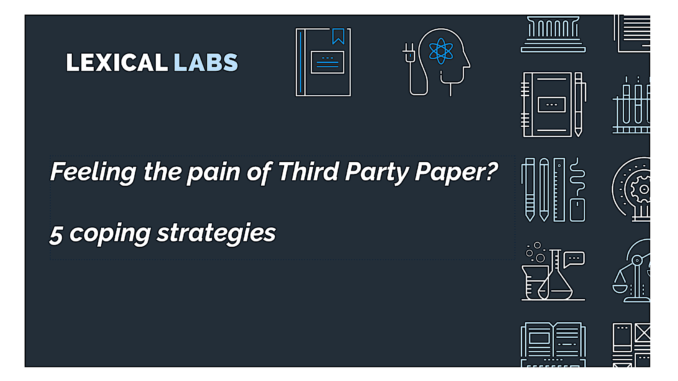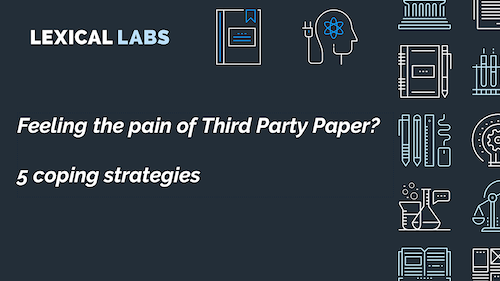
By Lexical Labs
Reviewing draft contracts from the other party in the negotiation, so called third-party paper, is like playing away in sport – home advantage counts.
Between 55-60% of American Football and around 65% of English Premier League matches are won by the host. In contracting, the playing away disadvantage is strong enough for 25% of General Counsel to cite ‘too much third-party paper’ as one of their top three headaches in a 2020 survey.
The big picture is that all top executives want their departments to digitise and become data powered. Third-party paper creates a massive barrier to this. The solution is process improvement aligned with technology.
Why the pain?
Own-terms contracts are structured data which has a profound impact at each stage of the contract lifecycle. Contracts can be created at a press of a button after completing a short questionnaire. Business teams can ‘self serve’, often producing the draft contract and entirely negotiating it using playbooks. Everything is geared to the processes of the home team. Data flows seamlessly into contract lifecycle management (CLM) systems, in turn meaning easier post-signing contract management.
The opposite is true of third-party paper. They are a jumble of words rather than a structured database. A simple concept like warranty period has thousands, if not millions, of variations. They are mostly settled through email tennis exchanges and difficult to put into an efficient process. Contracts are often held-up in Legal. Data extraction and capture is either missed or done manually. Contract management is time consuming. There are big staff wellbeing issues created around repetitive contract review. In a nutshell – a nightmare.
Can’t we just insist on our own terms? Great if you are always the biggest gorilla in the forest. But if not, or business circumstances dictate otherwise, you’ll be dealing with some third-party paper.
Five Pain Relief Remedies
1. Internal processes:
Even with the technology available, reviewing and negotiating contracts is largely manual and heavily reliant on humans. The processes and tools must be fit for purpose. Contract triage is critical. Contracts should come in a single front door, pre-screened for value and risk and sent down different rails. Low-value contracts can be handled by business managers, others by specialist contract managers and higher value ones involving Legal. Have clear templates for review output –issues lists for example. Use the dashboards, workflows and other tools in your existing CLM or matter management system. Finally, have a process which helps the data transfer later on.
2. Dealing with the other side:
Have a template workflow that you agree with the other side which sets out the process up to signing. This should include any platforms or technology which will be involved. Leverage your counterparty’s technology and process – if they have a smart contracting platform, such as Juro or Avvoka, with documents in a web browser and negotiation functions, use it – it’s free! Set a timetable and regular calls if necessary. Identify any schedules that need to come from the reviewing party. Agree an order sheet or brief term sheet. Set expectations. Send a sheet of must haves or red flags in advance of the contract. Delay the drafting until these are agreed in principle. Don’t redline and trade drafts (until the last draft). Send a clear issues list, agree conceptually and record this. Simple stuff, but contract parties often overlook the huge time saving that can be reaped by having simple but effective processes between the parties.
3. Playbooks are essential:
How often do you hear the comment ‘we don’t have time to set-up playbooks’. This doesn’t need to be so. Get your business and legal teams in a meeting for two hours and write on post-it notes (ideally digital ones) the key clauses and concepts and the usual sticking points, normal fall-back positions and outcomes (using the 80:20 rule – focus on the 80% of issues that can be addressed in 20% of the time). This is your first draft playbook. Review, adjust and expand it regularly. Finally, playbooks are even better if digital (see ‘Use technology wisely’ below).
4. Use technology wisely:
Until now, technology played a limited role in reviewing and extracting data from third-party papers. Now, it is becoming central to (i) negotiation and (ii) contract data management.
Over-hyped AI is not helping. The natural language processing (NLP) technology in most CLM systems can do a deviation analysis from a common starting point. This is fine for own terms but not for third-party paper which comes in many shapes and sizes. So, most users don’t bother using these features. Similarly AI technology that automatically amends third-party paper is fine for simple contracts but struggles beyond this.
We should be using technology more effectively.
This could start with simple rule-based technology driving a triage system. Users manually input data and the contracts are prioritised and sent to the right place. Some simple AI technology could then be introduced to automate fully the triage, without need for data input by humans. Use triage as a way of building confidence in the AI – which will improve over time.
Beyond that, the more powerful NLP systems, such as Tiro’s from Lexical Labs, have a combination of cutting edge AI, a logic based expert system and a digital contract playbook.

Tiro has an NLP and machine learning engine that learns to understand key concepts in a contract. So like other systems, it can, for example, identify and extract an IP indemnity in whatever form it exists in a third-party paper. Tiro’s logic-based expert system is then able to analyse those concepts in very granular detail. For example, understanding who gives the indemnity, what it covers, whether it is capped and what it excludes.
This core technology sits at the heart of a digital contract playbook.The user can review third-party papers against their playbook rules, see red flags or amber warnings and get smart summaries of key issues. They can then access fall back wording, amend the drafts and create reports and issues lists.
In a nutshell, start simply, empower – not replace – humans, and embed digital contract playbooks.
5. Capture, transfer and analyse data:
Currently this is being done manually. Technology should digitise third-party paper and capture relevant contract data and metadata and transfer it into enterprise software. The technology must be fit for purpose.
For example, a manufacturing company may include contract risk scoring on an overall risk and reward evaluation of its customers using manual data input into its own software. The contract risk scoring can be automatically fed into the software.
Similarly, by feeding this data automatically (not manually) into CLM systems, their post signing contract management features can be fully utilised. This means the true potential of the CLM system and its return on investment can be realised.
The longer term objective is for Corporate Legal and Contract Managers to become ‘data powered’. Technology will play a huge role, particularly in turning unstructured data in third-party paper into actionable insights.
The technology will evolve so that users can ask questions of the contracts and receive instant responses. What is the contract term? When is my next report due? Is there any automatic renewal and when? Which contracts have ‘change in control’ provisions?
Beyond these basic contract management tasks, users can move into advanced analytics which leverage strategic value from their contract portfolio. What cross-selling opportunities exist between divisions in a company? What correlation exists between the terms of my contracts and my profits?
The end game
In 10-20 years, the concept of ‘third-party’ paper may disappear altogether. Industry bodies may standardise to such an extent that the difference between playing ‘home’ and ‘away’ becomes marginal.
For now, we need to deal with the pain of third-party paper by good processes and taking small steps, one yard at a time, with technology. In time, they will lead to a home run.
—
If you would like to learn more about this subject or what Lexical Labs can do for you, please see here.

[ Artificial Lawyer is proud to bring you this sponsored thought leadership article by Lexical Labs. ]